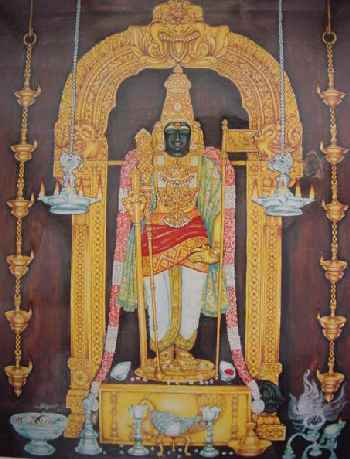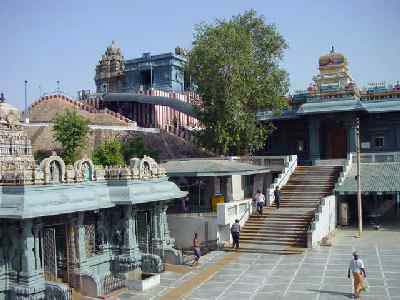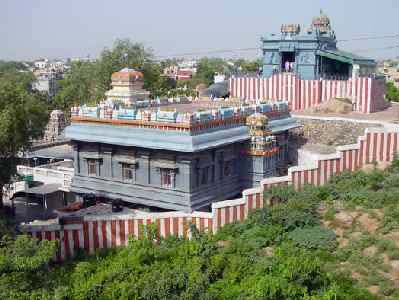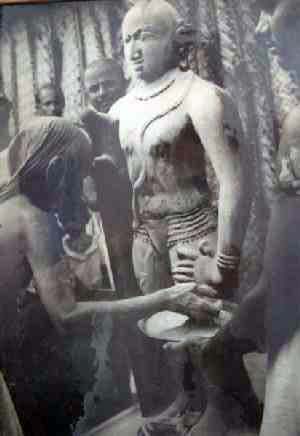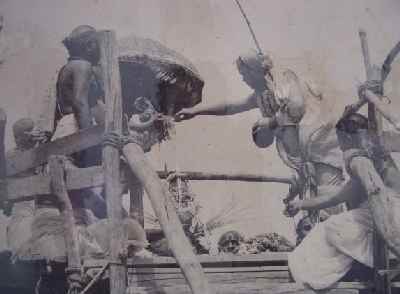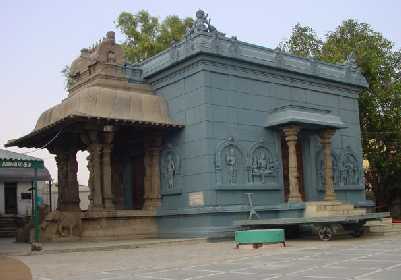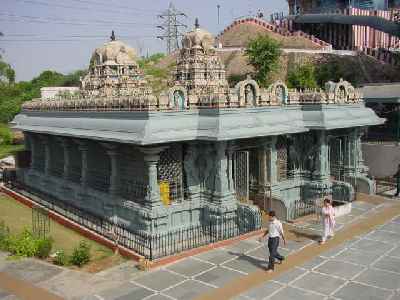
|
||||||||||||||||||
|
| ||||||||||||||||||

Uttara Swami Malai Temple, New DelhiJune 2001 MahakumbhabhishekamHistory of Uttara Swami Malai Temple
Click here for more about the Maha Kumbhabhishekam for Malai Mandir conducted on June 27th 2001.
|
|
|
|
|
In the meantime, on June 2, 1967, the Sila Sangrahanam (stone acquiring) ceremony for the Moola Vigraham of Lord Swaminatha was performed at Tirunelveli. With blessings of the Sankaracharya of Kanchi Kamakoti Peetam and Arulnandi Tambiran Swamigal of Tirupanandal, the stone for the main idol of Lord Swaminatha was located and lifted from the bed of the Tambaravaruni River. It appears that the present moolavigraham in Śrī Subramania Swami Temple on the seashore at Tiruchendur was carved out sixty years earlier from another portion of the same bedrock. The Tambara Varuni stone was brought to Mahabalipuram for making the moolavigraha . It took nearly thirty months to sculpt the idol of Śrī Swaminatha. In April 1970, the idol was taken to Kanchipuram to be blessed by His Holiness the Sankaracharya Śrī Chandrasekarendra Swamigal. His Holiness was pleased at the workmanship and performed special abhishekam and archana to the moola vigraha . It was then brought to Uttara Swamimalai and kept in dhanya vasa .
The first instalment of five wagons of carved stones from Walajabad arrived in New Delhi by rail in December 1968, to be followed by another 14 wagons in May 1969. The skilled workers from Walajabad then began giving the finishing touches and the work of assembling commenced.
In Septermber 1969, the foundation work was completed and the work of actual erection was taken up. The Garbha Nyasa function was performed on 26 April 1970 by His Holiness Śrī Krishna Bhodasrami Swamigal, the then Sankaracharya of Jyotir Math.
|
|
|
|
Early in 1973, the temple was ready for consecration. On the invitation of the Samaj, His Holiness Jagadguru Sankaracharya Śrī Jayendra Saraswati Swamigal of Kanchi Math undertook a padayatra of 2,400 kilometres from Kanchipuram to Delhi via Tirupati, Hyderabad, Nagpur, Jhansi, Gwalior, Agra and Mathura, covering a period of four months from the middle of February 1973 to early June of that year. On June 4, 1973, the Jagadguru performed the Yantra Sthapana ceremony. On the same day, H.H. Śrī Niranjana Dev Tirtha Maharaj, the Sankaracharya of Govardhan Peetham, Puri and H.H. Śrī Krishna Bodhasrami Maharaj, the Sankaracharya of Jyotir Math, visited the temple and had darshan of the Lord in Jaladinivasa.
The Maha Kumbhabhishekam on the 7th June 1973 was acknowledged to be the biggest event of the decade. Over three lakhs of people witnessed the Kumbhabhishekam performed by Sarva Sadakam Sivachariar Ayyamani Sivam in the august persence of His Holiness the Sankaracharya of Kanchi Kamakoti Peetam. There were 47 homa kundams (holy fires) and 64 kalasams set in the Yaga Sala and over 100 sivachariars and vedic scholars from various parts of India performed the homams, pujas and other rituals. His Holiness visited the Yaga Sala several times and gave several useful directions to the sivachariars and vedic scholars.
Śrī R. Venkataraman was the President of the Samaj. On his appointment as the Union Finance Minister in January 19880, and on his advice, Śrī T. Swaminathan, I.C.S., the thenChief Election Commissioner, became the Chairman of the Board of Management. Śrī T. Swaminathan could not continue as Chairman of the Board of Management of the Samaj due to ill health and the stewardship of the Samaj passed on the Śrī R. V. Subrahmanian, I.A.S. (Retd), who continues to be the President. Śrī R. Venkataraman, the former President of India, is the Patron-in-Chief of the temple.
Built on top of the 90 feet high hillock at a cost of Rs. 14 lakhs, the temple of Lord Swaminatha has several unique features. this is the only temple where Brahmasthana Prathista has been done. Deities delineated in human form are not normally house in the Brahmasthana or the very centre of the garbha graha. Lord Skanda is an exception. The shrine has become famous as Sahasrara Kshetra and has been sung by poets as the seventh Padai Veedu. The six important shrines of Lord Subrahmanya at Tiruchendur, Tirupparankundram, Swami Malai, Palani, Pazhamudircholai and Tiruttani represent the six centres (cakras) Mooladhara, Swadisthana, Manipuraka, Anahata, Visudhi, and Agyaya. The Sahasrara of Brahmarandhra Kshetra was missing all these centuries and Uttara Swami Malai has filled the void.
There is evidence in the Mahabharata to show that Rohtak (about 25 miles from Delhi) was the stronghold of Matha Mayurakas and that their cherished deity was Karttikeya. This Uttara Swami Malai is the one shrine which has been visited by the Sankaracharyas of all the five maths: Bhadri, Dwaraka, Kanchi, Puri and Sringeri. This is also the only temple where the Sarva Vasikarana Yantra is embedded under the deity. This yantra is the strong magnet attracting all irrespective of caste, creed, race, religion or nationality to this great shrine.
The temple of Lord Swaminatha is assembled and not constructed. The 900 massive stones, some of them weighing three to four tons each, stand assembed together without the use of cement or mortar. Only the crevices have been filled with the time-tested adhesive material made of lime and sand, gound to a paste with molasses and fruit juice.
At the instance of His Holiness Jagadguru Sankaracharya of Kanchi Kamakoti Peetam, the Samaj took up the construction of the Silpa Kala Mandapam. It does not house any deity but houses several ezquisite sculptural pieces like the lion pillar, the trellised window, the music pillar, the stone chain and the stone bull. It took five years to complete this showpiece of South Indian temple architecture and sculpture at a cost of Rs ten lakhs. This was inaugurated on 18 September 1983 by Śrī R. Venkataraman, then Union Finance Minister and thrown open to the public.
|
|
|
|
|
|
|
|
The next important step was to build a temple of Devi Meenakshi and Lord Sundareswara. The Sankaracharya of Kanchi advised the Samaj to construct this temple on the pattern of the great Madura temple. The work was entrusted to Śrī Ganapati Sthapati of Badrachalam Temple reputation. He prepared the design and left the actual execution to his younger brother Śrī Muthiah Sthapati, who has to his credit the construction of several temples both in India and abroad.
The work on the construction of the Meenakshi Sundareswara Temple as well as the temple for Lord Vinayaka commenced in 1986. The Sila Nyasam was performed on the 6th February 1986. When the edifice reached the garbha griha level, the garbha nyasam was performed on the 6th July 1987. The garbha griha containers were laid for all the three shrines by Śrī Vidya Peethadhipati Śrī Vidya Guru Śrī Vimarshanandendra Saraswati Maharaj of Bhaskara Prakasa Ashram, Madras.
While the brick construction was progressing at Delhi, the idols to be installed in the new temple were being carved at the sthapati's work centre at Palavakkam, Madras. It was decided that the lingam to be installed as Sundaresa should be a bana lingam drawn from the Narmada River. An exquisite piece of emerald colour stone about 1"9" high and about three feet in circumference was slelected from among the several stones available at Omkareswarar on the Narmada. The construction work at Delhi and the carving of the idols were completed in January 1990 over a four year period. The bana linga of Lord Shiva, the idol of Meenakshi and some of koshta vigrahas including Veena Dakshinamurti were taken to Kanchipuram to be blessed by His Holiness the Sankaracharya Śrī Chandrasekarendra Saraswati Swamigal in February 1990. His Holiness offered puja to the vigrahas.
The yantra sthapana of the new temple was performed at midnight on the 11th June 1990 by maharaj Śrī Gokulananda Saraswati Swamigal of Ramakrishna Math, New Delhi.
The Maha Kumbhabhishekam of the new temple and Jeernodhanrana Kumbhabhishekam of Lord Swaminatha Temple were performed on the 13th June 19990 at 6:45 am. Eighty sivacharyas drawn from various temples in the South and fifty Vedic scholars participated at the six kala yagas that preceded the kumbhabhishekam. There was recitation of the Rgveda, Krishna and Sukla yajurveda, Samaveda and Atharvaveda from dawn to dusk each day by selected Vedic pandits deputed by the Adi Sankara Advaita Research Centre, Madras. The kumbhabhishekam was performed in the august presence of Their Holinesses Śrī Gokulananda Saraswati, SrilaŚrī Śrī Muthikumaraswami Tambiran Swamigal of Tirupanandal and SrilaŚrī Ilvarasu Tambiran of Tiruvaduthurai Adheenam.
In strict accordance with the agamic rites and rituals, four kala pujas are being performed daily at all the shrines. The Samaj is administering a Pooja Trust Scheme for the well-being of the devotees and their families. Under this scheme, any person can donate a sum of Rs. 4,000 only and, on a date specified by the donor, the Samaj will perform four kala pujas for the specified deity in perpetuity on behalf of the donor for his andhis family's welfare.
Among the dignitaries who visited the Temple on the kumbhabhishekam day were the President of India Sr. R. Venkataraman, Vice-President Dr. Shankar Dayal Sharma and Air Chief Marshal (Retd.) Arjun Singh, Lt. Governor of Delhi. The Samas is beholden to Śrī lR. Venkataraman, who is its Patron-in-Chief, for his abiding interest in the activities of the Samaj from its inception.
While the Swaminatha temple had adopted the Chola style of architecture, the Sundareswara Temple has adopted the Pallava style and the Meenakshi temple the Pandya style. Thus, the Uttara Swami Natha Malai is a unique blend of all the three ancient and renowned styles of South India temple architecture and sculpture.
Since 1990 a temple hall for Adi Sankara has also been constructed on the premises of Uttara Swami Natha Malai. Today one may say without any gainsaying that a magnificent effort has been made to bring the glory of South Indian temple architecture and sculpture to the North.
Article taken from the Maha Kumbhabhishekam souvenir of Śrī Meenakshi Sundareswarar Temple, 13 June 1990.
|
For more detailed information about Uttara Swamimalai, contact:
V.V. Murthy, Executive Officer
Tel. 616-3373, 617-5104, (res.) 553-5774 Malai Mandir website: malaimandir.org |
